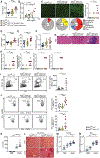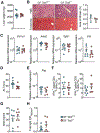Tet2 deficiency drives liver microbiome dysbiosis triggering Tc1 cell autoimmune hepatitis
- PMID: 35658976
- PMCID: PMC9841318
- DOI: 10.1016/j.chom.2022.05.006
Tet2 deficiency drives liver microbiome dysbiosis triggering Tc1 cell autoimmune hepatitis
Abstract
The triggers that drive interferon-γ (IFNγ)-producing CD8 T cell (Tc1 cell)-mediated autoimmune hepatitis (AIH) remain obscure. Here, we show that lack of hematopoietic Tet methylcytosine dioxygenase 2 (Tet2), an epigenetic regulator associated with autoimmunity, results in the development of microbiota-dependent AIH-like pathology, accompanied by hepatic enrichment of aryl hydrocarbon receptor (AhR) ligand-producing pathobionts and rampant Tc1 cell immunity. We report that AIH-like disease development is dependent on both IFNγ and AhR signaling, as blocking either reverts ongoing AIH-like pathology. Illustrating the critical role of AhR-ligand-producing pathobionts in this condition, hepatic translocation of the AhR ligand indole-3-aldehyde (I3A)-releasing Lactobacillus reuteri is sufficient to trigger AIH-like pathology. Finally, we demonstrate that I3A is required for L. reuteri-induced Tc1 cell differentiation in vitro and AIH-like pathology in vivo, both of which are restrained by Tet2 within CD8 T cells. This AIH-disease model may contribute to the development of therapeutics to alleviate AIH.
Keywords: Lactobacillus reuteri; Tc1 cells; Tet2; aryl hydrocarbon receptor agonist; autoimmune hepatitis; liver microbiome.
Copyright © 2022 Elsevier Inc. All rights reserved.
Conflict of interest statement
Declaration of interests The authors declare no competing interests.
Figures







References
MeSH terms
Substances
Grants and funding
- R01 CA253329/CA/NCI NIH HHS/United States
- P30 CA047904/CA/NCI NIH HHS/United States
- R21 CA259636/CA/NCI NIH HHS/United States
- S10 OD023402/OD/NIH HHS/United States
- T32 GM007281/GM/NIGMS NIH HHS/United States
- T32 AI089443/AI/NIAID NIH HHS/United States
- R01 DK130897/DK/NIDDK NIH HHS/United States
- K08 AR075056/AR/NIAMS NIH HHS/United States
- R01 AA021978/AA/NIAAA NIH HHS/United States
- R21 AI163503/AI/NIAID NIH HHS/United States
- R21 AI163721/AI/NIAID NIH HHS/United States
- R01 AA030007/AA/NIAAA NIH HHS/United States
- R01 AA028436/AA/NIAAA NIH HHS/United States
- P30 DK120531/DK/NIDDK NIH HHS/United States
LinkOut - more resources
Full Text Sources
Molecular Biology Databases
Research Materials

